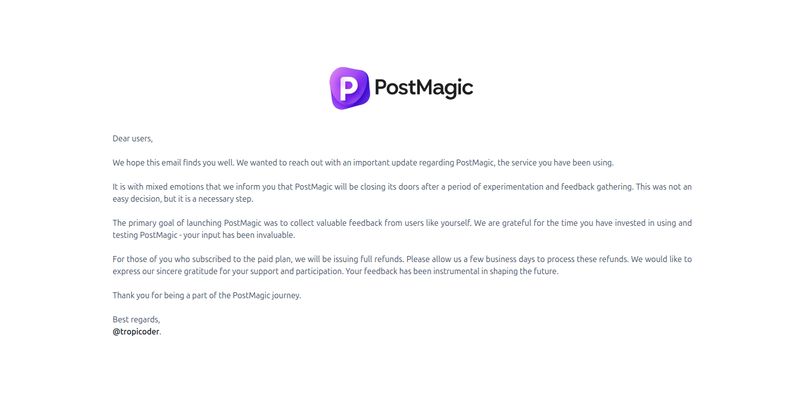Well, another one’s gone. If you're in the marketing or tech world, you get used to the churn. New tools pop up like mushrooms after a rainstorm, each promising to be the next big thing, the one app to rule them all. And just as quickly, some of them vanish. This week, the bell tolls for PostMagic.
I got the email, and I'm sure many of its early users did too. It was a classic, respectable shutdown notice. Polite, a little somber, and straight to the point. It’s a familiar story, but one that always gives me pause. It’s a reminder of how incredibly volatile this space is. One day you're integrating a new tool into your workflow, the next, you're looking for an alternative. So, let’s talk about it. What was PostMagic, what did it try to do, and what can we learn from its brief flicker of existence?
So, What Exactly Was PostMagic Supposed to Be?
At its core, PostMagic had a pretty bold proposition. It wasn't just another social media scheduler. Oh no, it was much more ambitious. The platform was built to help users generate hundreds, even thousands, of posts or reactions for multi-account campaigns. The stated goal was to “amplify your voice and increase your impact.”
Think about that for a second. It wasn't about queuing up your own handcrafted content. It was about creation and reaction at scale. In my head, I pictured it as a sort of digital printing press for opinions and engagement. You set the parameters, and it would go to work, populating your various social media timelines with content. It aimed to be the ghost in teh machine for your social media army, whether that army was for a single brand with multiple channels or a larger influence campaign.
The Allure of Multi-Account Automation
I get the appeal, I really do. If you're a campaign manager or a brand strategist juggling a dozen different accounts—maybe a main brand account, a CEO's personal brand, a support channel, and a few product-specific profiles—the idea of automating some of that content flood is tantalizing. It promises efficiency. It promises a consistent baseline of activity, ensuring your digital storefronts never look abandoned. For a political or social cause, the ability to rapidly scale a message across numerous friendly accounts could seem like a game-changer. This was the magic it was selling.
The Shutdown Email: Reading Between the Lines
Here’s the email that went out. It’s always interesting to see how companies handle this delicate moment.

Visit PostMagic
It's a classy breakup letter, you have to admit. “Mixed emotions,” “not an easy decision, but a necessary step.” They frame the whole thing as an “experimentation and feedback gathering” phase. And I don’t doubt that’s true. Most startups are, at their heart, just a big experiment. They also did the right thing by issuing full refunds to paid subscribers, which builds a surprising amount of goodwill even as you’re closing up shop.
But as an industry vet, my mind immediately starts to wonder about the subtext. Was it a classic case of a solution looking for a problem? Or maybe, just maybe, the ethical tightrope of generating thousands of “reactions” was just too precarious to walk. It's one thing to schedule posts; it's another to automate what looks like genuine human interaction. The big social platforms are getting notoriously aggressive about what they call “inauthentic coordinated behavior.” A tool that lives in that gray area is a risky bet.
The Fine Line Between Amplification and Automation Overload
This whole situation really shines a light on a bigger debate in our field. Where is the line? I’ve always been a bit wary of tools that promise to generate engagement. It feels like it teeters on the edge of authenticity. We use schedulers like Hootsuite or Buffer to make our lives easier, but the content, the voice, is still fundamentally human.
When you start auto-generating reactions, you risk turning social media into a conversation between bots. It devalues real engagement. If a user suspects your witty reply or supportive comment was generated by an algorithm, you don't just lose a follower; you erode trust. And in marketing, trust is pretty much the only currency that matters in the long run.
Why Ambitious Tools Like This Can Stumble
I don't have any inside info from the PostMagic team, but tools like this often face a few common, giant hurdles:
- Product-Market Misfit: The idea might be cool, but is it a big enough pain point that a critical mass of people will pay for it? Maybe not.
- The Ethical Minefield: As mentioned, the fear of being branded a “spam tool” is real. It can scare away investors, users, and get you blacklisted by the very platforms you need to function.
- Technical Wars: Social media APIs are constantly changing. Staying compliant and functional is a never-ending battle that requires significant resources. One update from X (formerly Twitter) or Meta could render your core feature useless overnight.
What This Means for Us Boots-on-the-Ground Marketers
The lesson here isn’t “don’t use tools.” It’s “don’t put your faith entirely in them.” A tool is a lever, not a strategy. The fall of PostMagic is a fantastic reminder to not get too attached to any single piece of software, especially one that’s new and operating in a legally or ethically fuzzy space. Diversify your toolkit, but more importantly, solidify your strategy. A great tool can't save a bad plan, but a great plan can survive the loss of any single tool.
Looking for a PostMagic Alternative? Here's a Better Idea
If you were a PostMagic user or were intrigued by its promise, you might be searching for a replacement. My advice? Don't look for a 1-to-1 alternative. Instead, look for tools that support and enhance human effort, not replace it entirely. Focus on platforms that help with content ideation, provide deep analytics so you know what resonates, and offer smart scheduling to post at optimal times. Look for tools that bring all your conversations into one place for genuine, one-on-one engagement. The goal should be to make the human touch more efficient, not to eliminate it.
Frequently Asked Questions
- What was PostMagic?
- PostMagic was a software tool designed to automatically generate large volumes of social media posts and reactions for users managing multiple accounts, with the goal of amplifying their message and impact.
- Why did PostMagic shut down?
- According to their official announcement, PostMagic was closing down after a period of experimentation and feedback gathering. While the exact reasons weren't detailed, such closures in the SaaS industry are often due to a combination of factors like lack of product-market fit, technical challenges, or strategic pivots.
- Did PostMagic offer refunds to its users?
- Yes. The company stated clearly in its shutdown notice that all users who had subscribed to a paid plan would be receiving a full refund.
- What is multi-account campaign management?
- This is the practice of managing social media strategies across several different accounts simultaneously. This can include different accounts for one brand (e.g., main, support, regional) or managing the accounts for multiple clients or personas.
- Are there direct alternatives to PostMagic?
- Finding a tool that specifically auto-generates posts and reactions at scale is difficult, as many operate in a gray area regarding social media platform terms of service. A better approach is to look for established social media management platforms like Hootsuite, Buffer, or Sprout Social that focus on scheduling, analytics, and engagement management to make a human marketer more efficient.
- Is automating social media a good idea?
- Automating certain tasks, like scheduling posts, can be very efficient. However, automating engagement, like comments and reactions, is generally viewed as risky and inauthentic. The best strategy is often a hybrid approach: automate logistics but keep the actual conversation and engagement human.
A Final Thought on Tech's Grand Experiments
So, we say goodbye to PostMagic. It’s easy to be cynical, but I honestly have a lot of respect for anyone who tries to build something new. Innovation isn’t clean; it’s messy and full of failures. Every closed-down service is a lesson for the entire industry. It pushes the conversation forward about what we, as marketers and users, actually want from our tools and what constitutes genuine connection online.
So, hats off to the @tropicoder team for giving it a shot. And for the rest of us, it’s back to the drawing board, armed with a little more wisdom than we had yesterday.
Reference and Sources
- CB Insights - The Top 12 Reasons Startups Fail
- Social Media Today - The Pros and Cons of Automating Your Social Media Updates
- Facebook Community Standards - Inauthentic Behavior Policy



